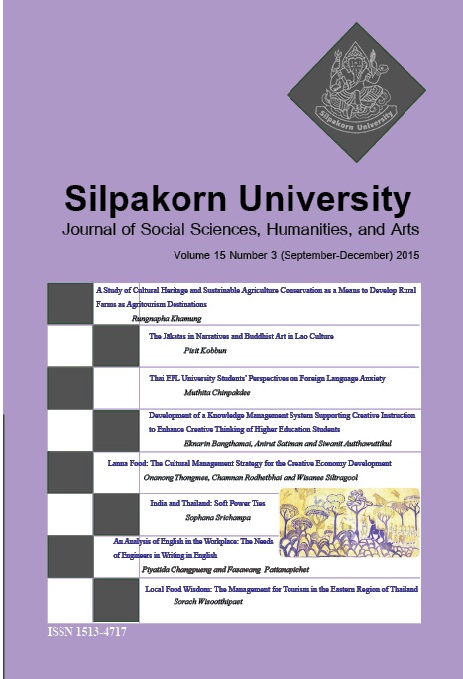Thai EFL University Students’ Perspectives on Foreign Language Anxiety
Main Article Content
Abstract
The purposes of this study are to find out the level of foreign language anxiety perceived by Thai EFL learners through identifying their possible causes of foreign language anxiety and determining the potential solutions to minimize their English language learning anxiety. Drawing upon the Foreign Language Classroom Anxiety Scale (FLCAS) and focus group interviews, the findings revealed that Thai EFL learners experienced a high level of anxiety both inside and outside language classroom contexts. Four main possible factors including academic evaluations, negative evaluations, comprehension problems, and teachersrelated factors were found to be contributing factors to Thai EFL learners’ foreign language anxiety. Lastly, suggestions were proposed in order to create low-anxiety foreign language classrooms.
Downloads
Article Details
All rights reserved. Apart from citations for the purposes of research, private study, or criticism and review,no part of this publication may be reproduced, stored or transmitted in any other form without prior written permission by the publisher.
References
Cheng, Y. S. (2001) Learners’ Belief and Second Language Anxiety. Concentric: Study in English Literature and Linguistics 27(2): 75-90.
Ehrman, M., Leaver, B. and Oxford, R. (2003) A Brief Overview of Individual Differences in Second Language Learning. System 31(3): 313-330.
Gregersen, T. (2003) To Err Is Human: A Reminder to Teachers of Language-Anxious Students. Foreign Language Annals 36(1): 25-32.
Gregersen, T. and Horwitz, E. K. (2002) Language Learning and Perfectionism: Anxious and Nonanxious. The Modern Language Journal 86: 562-570.
Horwitz, E. K., Horwitz, M. B. and Cope, J. (1986) Foreign Language Classroom Anxiety. The Modern Language Journal 70(2): 125-132.
Horwitz, E. (2001) Language Anxiety and Achievement. Annual Review of Applied Linguistics 21:112- 126.
Hsu, L. (2010) The Impact of Perceived Teachers’ Nonverbal Immediacy on Students’ Motivation for Learning English. Online Asian EFL Journal 12(4): 188-204.
Kitano, K. (2001) Anxiety in the College Japanese Language Classroom. The Modern Language Journal 85(4): 549-566.
Kondo, Y. (2010) A Study on Relationship between Language Anxiety and Proficiency: In a Case of Japanese Learners of English. [Online URL: https://www.paaljapan.org/ resources/proceedings/PAAL10/pdfs/kondo.pdf] accessed on October 1, 2014.
MacIntyre, P. D. and Gardner, R. C. (1989) Anxiety and Second Language Learning: Toward a Theoretical Clarification. Language Learning 39(2): 251-275.
Matsuda, S. and Gobel, P. (2004) Anxiety and Predictors of Performance in the Foreign Language Classroom. System 32(1): 21-36.
Mills, N., Pajares, F. and Herron, C. (2006) A Reevaluation of the Role of Anxiety: Self-efficacy, Anxiety, and Their Relation to Reading and Listening Proficiency. Foreign Language Annals 39: 276-295.
Oxford, R. L. (2005) Anxiety and the Language Learner: New Insights. In Affect in language learning, edited by J. Arnold, pp. 58-67. Cambridge: Cambridge University Press.
Plangkham, B. and Porkaew, K. (2012) Anxiety in Public Speaking Classes among Thai EFL Undergraduate Students. LEARN Journal: Language Education and Acquisition Research Network 5(1): 110-119.
Suwantarathip, O. and Wichadee, S. (2010) The Impacts of Cooperative Learning in Anxiety and Proficiency in an EFL Class. Journal of College Teaching and Learning 7(11): 51-58.
Tallon, M. (2009) Foreign Language Anxiety and Heritage Students of Spanish: A Quantitative Study. Foreign Language Annals 42(1): 112-132.
Tóth, Zs. (2009) Foreign Language Anxiety – For beginners Only?. In UPRT 2008: Empirical Studies in English Applied Linguistics, edited by R. Lugossy, J. Horvath, and M. Nikolov, pp. 225-246. Pécs: Lingua Franca Csoport.
Tóth, Zs. (2011) Foreign Language Anxiety and Advanced EFL Learners: An Interview Study. Working Papers in Language Pedagogy 5: 39-57.
Wilkinson, S. (2004) Focus Group Research. In Qualitative Research: Theory, Method and Practice, D. Siverman, pp. 177-199. London: Sage.
Williams, K. E. and Andrade, M. R. (2008) Foreign Language Learning Anxiety in Japanese EFL University Classes: Causes, Coping, and Locus of Control. Electronic Journal of Foreign Language Teaching 5(2): 181-191.
Wörde, R. (2003) Students’ Perception on Foreign Language Anxiety. Inquiry 8(1). [Online URL: https://www.vccaedu.org/inquiry/inquiry-spring2003/i-81-Wörde.html] accessed on October 1, 2014.
Wu, K. H. (2010) The Relationship between Language Learners’Anxiety and Learning Strategy in the CLT classrooms. International Education Studies 3(1): 174-191.
Young, D. J. (1991) Creating a Low-Anxiety Classroom Environment: What Does Language Anxiety Research Suggest? The Modern Language Journal 75: 426-439.


